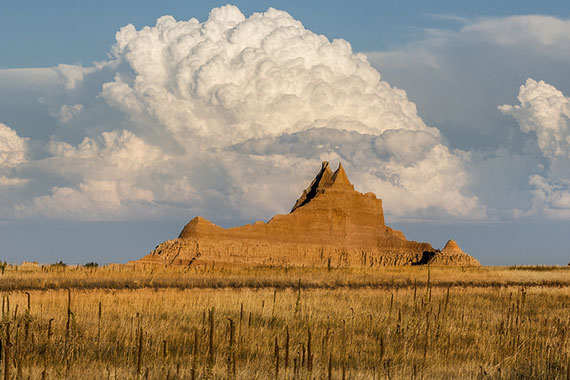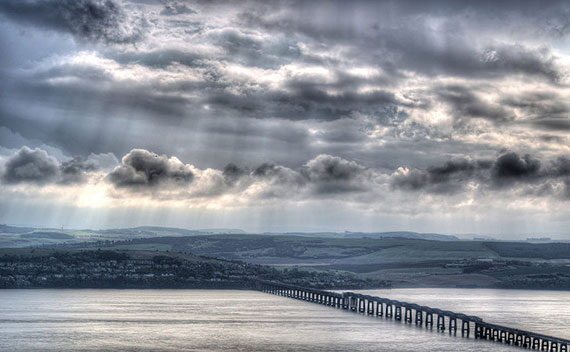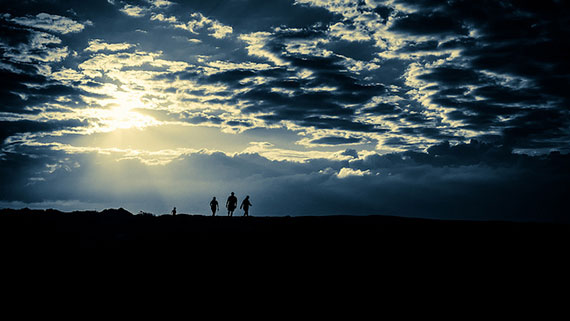How many beautiful nature pictures have we all seen with little or none of the sky-scape? You may think of the sky as only some unavoidable background for most of your nature photo subject matter, and the more blue it is, the better. Well guess what? Mother Nature has a treasure trove of eye catching possibilities up, overhead if you only take the time to have a look and know what to look for.

Photo by Christian Collins; ISO 100, f/9.0, 1/400-second exposure.
Lets start with the basics. Obviously, a beautiful clear, deep blue sky makes for a good backdrop for many subjects but can be rather dull by itself, as can a completely gray overcast sky. Now start adding fluffy white cumulus clouds and it starts getting more interesting, but it is only the beginning of the many opportunities the sky can provide for unique and pleasing photos.
Take fair weather cirrus and stratus clouds for instance. Their thinner and more spread out nature can provide a completely different look for your photo. Even at mid-day the sky can be gorgeous. For example an approaching thundershower can be striking with the billowing and ever changing shapes and textures, and bright white color as it approaches. It is like a mountain-canyon vista in the sky, and is easily captured compared to other faster moving, unpredictable subject matter. And you will have no problem capturing multiple, unique shots of the storm before it moves off or overhead because of its continual morphing of shapes and colors. Also some clear skies around the storm can add to its magnificence and enhance your image.
Using a digital camera for capturing mid-day storms is easy since auto mode frequently works well at adjusting the cameras ISO setting (light sensitivity), preventing overexposure of the clouds white colors and preserving the definition of their many shapes and edges. Some cameras may not do this as well as others, so manually adjusting the ISO setting may be required for best results.
Always remember when taking full sky-scape shots to have a clean sky, meaning nothing obscuring the view such as trees, buildings, power lines, etc. Of course those objects can work great in their own compositions, but at the moment we are concentrating on that big empty space overhead.

Photo by Neil Williamson; ISO 100, f/8.0, 1/321-second exposure.
Dusk and dawn sky shots are definitely the most colorful and one of my favorites. Sure, clear sunrises and sunsets are nice, but by far the best is when you have high, wispy, cirrus clouds, and mid level stratus to reflect the suns beautiful and ever changing colors as it rises or sets. Lower puffers or cumulus can add some nice contrast as long as they do not block the view of the higher ones which reflect most of the colors. All this is most easily captured over water or a flat landscape with no obstructions. A water vista often works best because of the additional color reflections.
I have found that the deepest reds and purples are from about 15-20 minutes before sunrise and after sunset, with the oranges and yellows occurring shortly before rise and set. Of course a vertically building cumulus cloud will reflect stunning colors as well during these times. I have seen large cumulus and stratus clouds light the area up like you were in a giant red, pink, or orange room, then fade away as the suns rays leaves them and hit the higher clouds.
You will want to make sure your cameras ISO setting in auto mode is adequate for the conditions when working in lower light levels. If not, try manually adjusting the setting to increase the cameras light sensitivity. Settings can vary from camera to camera, but you will be able to see when it looks right. This is when the sky still looks natural, not too bright or glowing, and not too dark or fuzzy. Try to match what the camera is picking up with what you see with your own eyes. Low light conditions can be tricky so take your time, being careful not to overexpose.

Photo by Jason Carpenter; ISO 800, f/11.0, 1/4000-second exposure.
Hopefully this information will encourage you to get out there with your camera and explore a part of nature that is often overlooked.
About the Author:
John King (Everglades Photography) is a pilot and amateur photographer residing in South Florida. His interests include kayaking, sailing, and nature photography, and he has recently completed the coastal portion of the Florida Master Naturalist Course.
Like This Article?
Don't Miss The Next One!
Join over 100,000 photographers of all experience levels who receive our free photography tips and articles to stay current:






i want to know a name of technique. This technique is take a photo 2 pic, one pic focus at sky and one pic focus at tower, and i use photoshop to cut the sky and move in the other pic, it has a nice pic but i don’t know a name of this technique. Can you help me,Sir?
Sky photography can indeed produce some wonderful images but this article is useless as an introduction to the topic. The author had nothing to say on the subject but what could have been covered in one sentence. What little he said about clouds could have been said by anyone, even me, and I am a total photography novice, although I have marveled at clouds of all types for years. Very disappointing article. I will look for an article by someone who is more knowledgeable on the topic and has something more to say about it.
John, you have some amazing photos on your everglades-photography web site. I particularly like the aerial shots taken above the clouds – a unique vantage point that we don’t see very often. Keith
Thanks, John, for the great tips. I love dark sky photography! It just looks so dramatic. It seems that the sky in beautiful landscape photos rarely has the same impact compared to what we remember.
I found another article on this subject that provides some additional useful tips about using polarizing filters and ways to manipulate your camera to get darker, bluer skies.
http://freephotocourse.com/how-to—dramatic-dark-sky-effect.html
Hope this is helpful to the budding photographers out there!
Jessica
hi my names kerry and am slowly getting the hang of photography.. i have a nikon d-70 as a starter for slr’s before i buy an expensive one incase this is out of my understanding levels. im struggling with no what iso to use. whats best for high light and whats best for lo light my camera can go between 200 and 1600… not sure im of the understanding that low iso i.e 200 is for bright light and that faster iso is for low light, but when i increase the iso i get a grainy effect over dark areas in a picture.. help.. thank u.
excellent write up. it’s true, the skies above can be excellent subjects of photos, and capturing that great unique one is definitely rewarding. great tips.